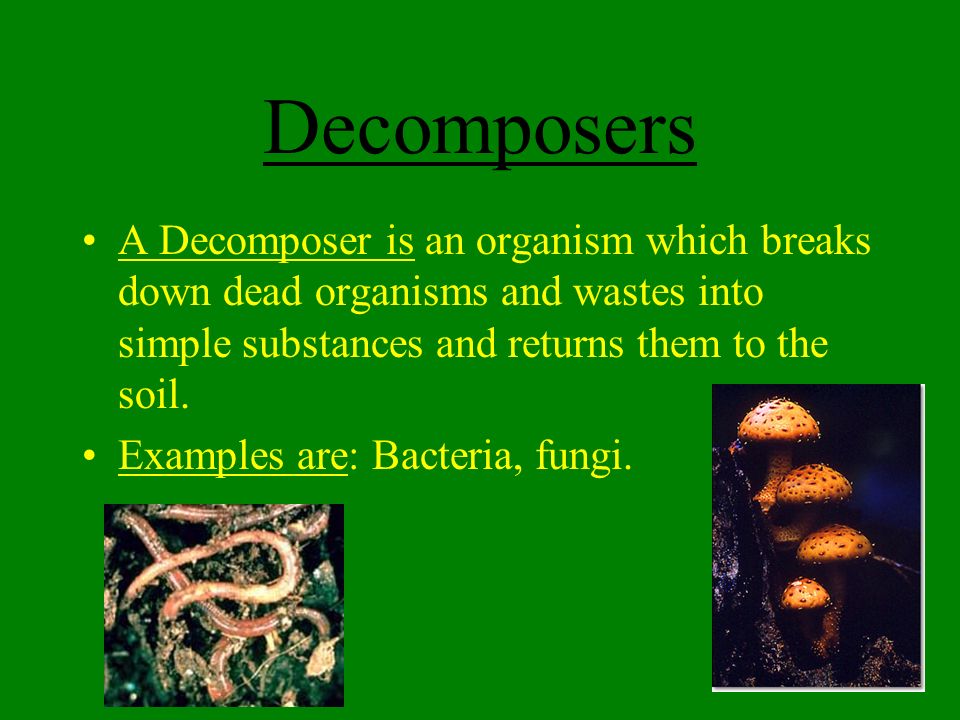an organism that breaks down wastes and dead organisms
The major part of digestion takes place in the duodenum. Explain double fertilization in plants.
 |
| Movement Of Matter 5th Grade Science |
Other protist species live on dead organisms or their wastes and contribute to their decay.

. The process by which the body breaks down food. Amoebas can be human parasites and can cause dysentery while inhabiting the small intestine. Bile breaks down fat into smaller particles. Another food chain in the same ecosystem might involve completely different organisms.
The removal process is known. After that the enzyme lipase digests fat into fatty acids and glycerol. Although the main role of sweat production is to cool the body and maintain temperature. The term disease refers to conditions that impair normal tissue function.
Without decomposers dead leaves dead insects and dead animals would pile up everywhere. However there are fundamentally different causes for each of these diseases. Skin Figure 1623 The purpose of sweat production is mainly to cool the body and prevent overheating but it also contributes to excretion. Dead plant materials such as leaf litter and wood animal carcasses and feces.
In the case of humans no less than other organisms death involves the collapse of integrated bodily. When any organism dies fungi and bacteria get to work breaking it down. EPA-6008-78-017 December 1978 MICROBIOLOGICAL METHODS FOR MONITORING THE ENVIRONMENT Wafer and Wastes Edited by Robert Bordner and John Winter Environmental Monitoring and Support Laboratory-Cincinnati Cincinnati Ohio 45268 and Pasquale Scarpino University of Cincinnati Cincinnati Ohio 45219 Prepared in part under EPA Contract No 68-03. The skin is part of the integumentary system but it also plays a role in excretion through the production of sweat by sweat glands in the dermis.
This process is called emulsification of fat. These fungi and bacteria act like built-in destructors. Your excretory system collects wastes produced by cells and removes these wastes from your body. Trypsin and chymotrypsin are enzymes which digest protein into amino acids.
This short food chain is one part of the forests food web. The singular form of bacteria is bacterium. A group of organisms called decomposers. Organisms interacting with their physical environment.
Microplastics are also found within the many other types of marine particles such as dead biological material tissue and shells and some soil particles blown in by wind and carried to the ocean by rivers. They perform a valuable service as Earths cleanup crew. In addition to aquatic protists several protist species are parasites that infect animals or plants and therefore live in their hosts. Decomposers feed on dead things.
When the fox dies decomposers such as worms and mushrooms break down its body returning it to the soil where it provides nutrients for plants like grass. An allele that produces the same phenotype whether its paired allele is identical or different. Its the mirror image of composing where something is created Some decomposers live in leaves or hang out in the guts of dead animals. These molecules into the blood to be carried throughout the body.
For example cystic fibrosis atherosclerosis and measles are all considered diseases. Nature has its own recycling system. Finally when the ratio of available carbon to available nitrogen is in sufficient balance nitrogen is released as ammonia. It is an organism having both male and female sex organs present in the same individual eg Rose Mustard Earthworm.
Bacteria Microscopic living organisms which can aid in pollution control by consuming or breaking down organic matter in sewage or by similarly acting on oil spills or other water pollutants. Hybridization using two traits with two alleles each. Cystic fibrosis CF is due to a specific genotype that results in impaired transport of chloride ions across cell membranes leading to. The Main Parts of the Digestive System are.
Thus the amount of carbon is reduced and the limited amount of nitrogen is recycled. Down food into molecules the body can. As other organisms use the nitrogen from the dead cells to form new cell material once more excess carbon is converted to C0 2. The organism stops functioning as an integrated unit and breaks down turning what was once a dynamic object that took energy from the environment to maintain its own structure and functioning into an inert piece of matter subject to disintegration and decay.
Upon reaching marine environments the fate of microplastics is subject to naturally occurring drivers such as winds and surface oceanic currents. Bacteria in soil water or air can also cause human animal and plant health problems. Under favorable conditions some. Put another way they decompose things.
It is an organism having male and female sex organs on two different types of individuals eg humans Papaya. The environment as it relates to living organisms. Solid wastes from the body. A caterpillar may eat the leaves of a tree.
Complex carbohydrates are digested into glucose.
 |
| Decomposers Science World |
 |
| Energy Flow In Ecosystems Ppt Download |
 |
| Decomposer Easy Science Ecosystems Science Flashcards Flashcards |
 |
| Solved What Are The Organisms Which Feed On The Wastes Or Dead Bodi |
 |
| Aim How Can We Describe Ecology And The Terms Used In The Unit Ppt Video Online Download |
Posting Komentar untuk "an organism that breaks down wastes and dead organisms"